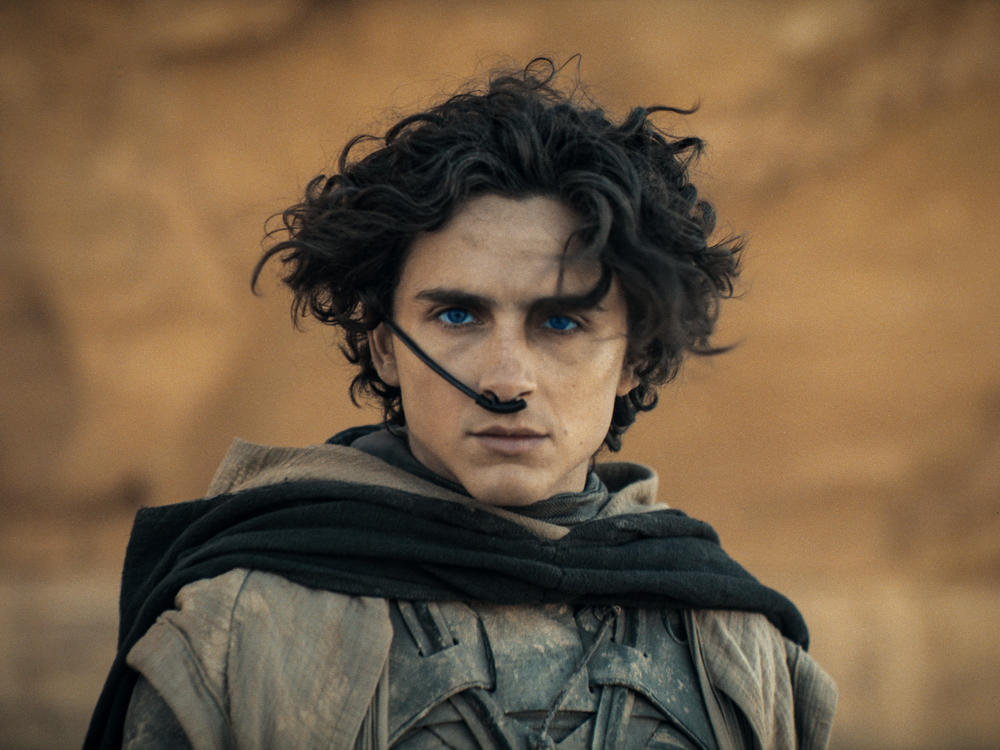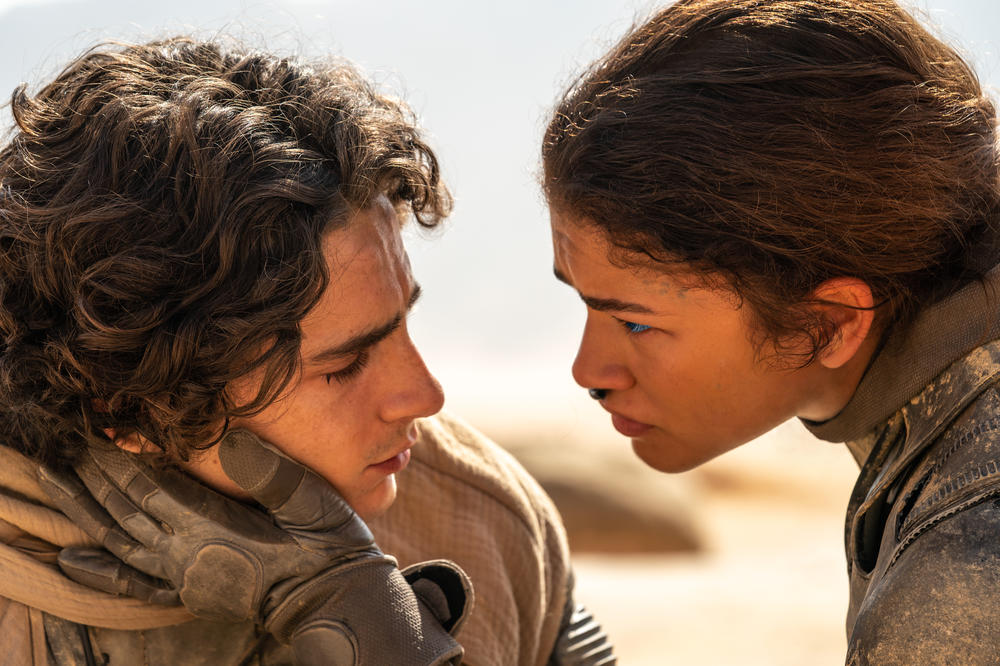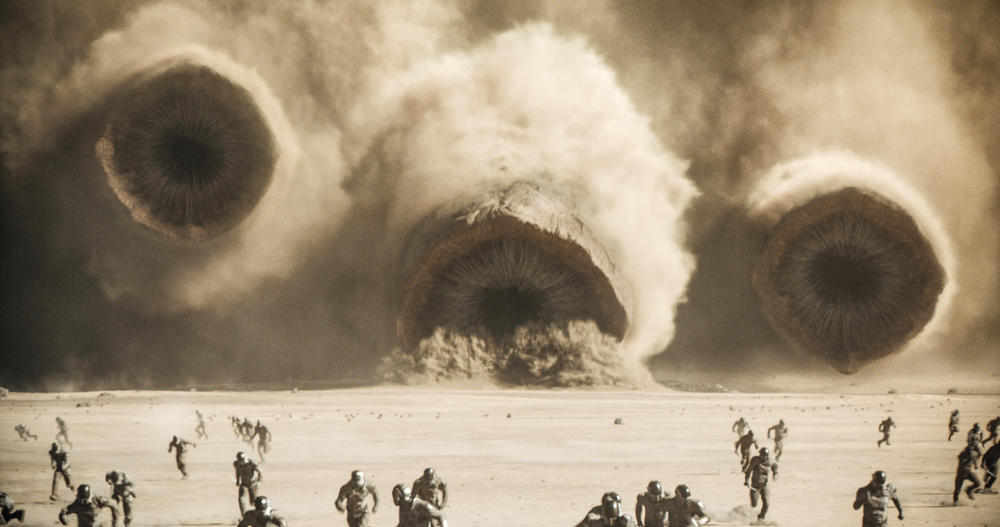Section Branding
Header Content
'Dune: Part Two' nails the dismount in the conclusion(?) of the sweeping sci-fi saga
Primary Content
It's been three years since Denis Villeneuve brought his twin directorial passions (breathtaking vistas, whispered dialogue) to bear on Frank Herbert's beloved 1965 sci-fi novel/spice-opera. Now that, with Dune: Part Two, he's nailed the dismount with such assured visual sweep and splendor — and enriched many of the novel's thin characterizations in the process — it's worth examining why his approach worked then, and works now.
After all, many before him had attempted to distill that thick book's internecine tale of disparate interests who jockey for galactic control using tools like war, eugenics, mind control and propaganda. What was so bracing about Villeneuve's 2021 film, besides its many, many arresting set-pieces, was its decision to leave all those plotting families and their deviously chewy schemes-within-schemes just sort of churning along in the background.
He had a primary job to do before turning to that stuff, which was to get audiences invested in his brooding hero, whose cheekbones were so sharp they could slice Pecorino and whose raven hair couldn't seem to help but swoop Byronically. That would be young Paul Atreides (Timothée Chalamet), who with his mother Jessica (Rebecca Ferguson) found himself stranded on the desert planet of Arrakis after his father was murdered by a treacherous rival family.
Colors of the world
Fortunately, Arrakis was home to an indigenous population called the Fremen who had adapted to living in the desert. They took Paul and his mother in – a strange decision made less strange once you realize that one of those aforementioned shadowy galactic groups had long ago planted prophecies among the Fremen of a savior who would come from another planet and lead them in an uprising that would turn Arrakis into a paradise.
The fact that said savior happened to talk and behave a lot like Paul? Yeah, that helped.
Villeneuve knew that beneath all the book's fussy business about trading charters and ancient mystic sects and the intricacies of space navigation, there was a very clear and simple Chosen One narrative, complete with reluctant hero, refusal of the call – the whole Joseph Campbell schmear, really. So that's what he set out to tell, though he did take the time to dress it up in epic battles and endless horizons and great cheekbones and Charlotte Rampling sniffily sniping at everyone while swanning around in a veil.
Spice up your life
Dune ended with Paul and Jessica encountering a Fremen tribe and its leader Stilgar (Javier Bardem). Part Two begins where it left off – with Paul making the acquaintance of one particular Fremen warrior named Chani (Zendaya), whom he'd previously glimpsed only through prophetic dreams.
The first film tackled the hard work of arranging the game pieces on the board, so Part Two swiftly sets about bashing them into one another. All those factional conflicts roiling away throughout the first film finally get to boil over at last.
There's the evil Harkonnens, led by a human pillbug of a Baron, played by Stellan Skarsgård and his fat suit. (The Harkonnens are bald and wear black; their crowd scenes look like a Palm Springs leather bar at happy hour.)
The Baron pits his two nephews, feral Rabban (Dave Bautista) and sinister Feyd-Rautha (Austin Butler), against each other. Bautista rages, Butler slithers – and pulls off an impressive Skarsgård impression while he's at it, proving 1. Sneery, grumbly line-readings run in the Harkonnen genes, and 2. His Elvis was no fluke, this kid's one gifted mimic.
Rising up against the Harkonnens are the Fremen, markedly and gratifyingly less monolithic here than they are in the book. Both Bardem and Zendaya get a lot more screentime this time out, and they each make the most of it, in vastly different ways. Stilgar is a true believer in Paul and his prophecy, yet Bardem doesn't play him credulous or naive; instead he finds the dry wit in the script's few jokes and proceeds to toss them away like the pro he is.
Zendaya's tough, independent Chani belongs to a younger generation of Fremen who see the prophecies around Paul for what they are – a clever marketing ploy, executed over hundreds of years via selective breeding. (Zendaya brings a grounded, searching ambivalence to her portrayal, which makes the Chani of the original novel seem like a one-note, lovesick child by comparison.)
And finally there's the emperor, Shaddam IV, played by Christopher Walken with what counts, for him, as restraint. His daughter Irulan (Florence Pugh) wasn't in the first film, but here she gets a few scenes to helpfully narrate the movie's many gearshifts for us – a role the character (her diary, anyway) plays in the book, too. In those fleeting glimpses we get of her, Pugh manages to invest Irulan with sufficient intelligence and empathy to justify her presence in this film, and to make you want to see more of her in the future.
Which is a sneaky way of telling you that the film only sort of concludes the story that the first film began. Here's why that's not a bad thing.
Slam it to the left
Nothing about Dune or Dune: Part Two feels padded or unnecessary. (Indeed, Herbert purists will complain about the wholesale eliding of entire plotlines – and one fan-favorite character, in particular.) Villeneuve carefully planted seeds in Part One that not only bear fruit in Part Two, but that fundamentally change the story being told in the process.
If you hadn't read the book, you might have come out of Part One thinking its story was simply yet another Chosen One narrative (which it was), and yet another White Savior narrative (which it wasn't, exactly): After all, no sooner does Paul arrive on Arrakis than some Fremen start to whisper he is the prophesied leader who will lead them to victory.
Villeneuve's decision to foreground Paul to the extent he did in the first film easily fed that reading. But in Part Two, the director makes explicit what he kept implicit before – various galactic puppetmasters emerge from the shadows, their agendas resolve into focus. This causes Paul's relationship to the Fremen to grow more complicated: Will he be their savior, or will he damn them to hell? Is he being used by others, or is he using them? Is he in control, or is he not?
Shake it to the right
Throughout the film, Villeneuve keeps adding texture to storylines and relationships that Herbert was content to keep smooth, or only introduce in later books. As a result, the film's conclusion feels far less conclusive than that of the novel.
But is that so bad, really? Especially if it means we might get Dune: Messiah: Part One a few years down the road, with Villeneuve at the helm?
In Villeneuve's hands, a sci-fi epic like Dune: Part Two can deliver what's expected – big stakes, big conflicts, big explosions – but it can do so in a clear and rigorously consistent visual language that serves the story. Even in the biggest battle scenes, his camera keeps us focused on what matters most – the human cost of it all. He closes in on eyes, hands, the movement of bodies. A wide shot which finds Harkonnen troops in black warsuits crawling over a sandy outcropping gets its visual and thematic echo later, in close-up, as black ants swarm over a human body.
Villaneuve finds moments like that one, and creates many others that the novel never even bothered to hint at, that collectively serve to deepen, humanize and ultimately improve both the story of Paul Atreides himself (as he did in Dune) and of everything he will unleash (in Dune: Part Two ... and, let's hope, in what comes next).



